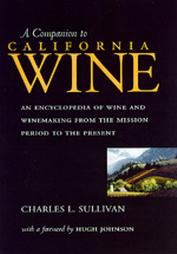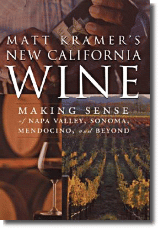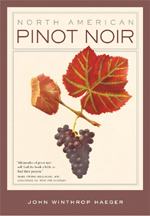The Canon of California Wine
By Tom Wark
 There is a common urge that overcomes just about everyone when they first discover wine—I mean really discover it. You want to know more! You want to know everything. Which vintage? What do those words on the label mean? Who makes the best wine? What is malolactic fermentation? All of a sudden this new passion starts to look pretty daunting. It’s about this time you discover something else. Something wonderful.
There is a common urge that overcomes just about everyone when they first discover wine—I mean really discover it. You want to know more! You want to know everything. Which vintage? What do those words on the label mean? Who makes the best wine? What is malolactic fermentation? All of a sudden this new passion starts to look pretty daunting. It’s about this time you discover something else. Something wonderful.
Wine literature.
Some would argue it’s the complexity of wine that has resulted in an entire genre of writing devoted to fermented grapes. Yes, wine can be complex. There are thousands of wines, from thousands of vineyards, from vintages that literally go back millennia. But I think the desire to put wine words on paper is more than just a matter of complexity. After all, making soap is a complex business, but you don’t see entire sections in bookstores devoted to the subject.
Wine, and drinking it in particular, really does stir the mind and soul. The sensual delights of wine, some from the alcohol, some from the flavor and aroma, capture us. Then there is the beautiful idea that a single bottle of liquid can represent a single piece of land at a particular point in time that can cause us to go on, and on, and on and on.
So it is that a richly stocked shelf of wine books is critical to not only the novice wine lover, but also to the experienced oenophile who is looking for reference. But where to start in building the collection? I’m going to start in California, only because this is where I live, work and write. What follows is:
The Canon of California Wine Literature: The Books You Need to Understand the California State Wine.
1. A COMPANION TO CALIFORNIA WINE, By Charles Sullivan. 1998
Charles Sullivan is the great California wine historian. He has written extensively on the subject with books on Napa Valley wine history and the importance of Santa Cruz to the founding of the California wine industry, and in the pages of The Wine Spectator, Wines & Vines Magazine, Vintage Magazine and The Journal of The American Wine Society. But it is this book that will remain as his gift to wine lovers decades from now.
Taking topics in alphabetical order, Sullivan hits the main topics (varietals, appellations and wineries) as well as the obscure (how the French term “Sauterne�? came to be used in California for white wine during the mid 19th century). “Companion�? is filled with maps of regions, vintage photos, old labels and tables outlining grape and wine production in the state.
This is not a book of wineries. Though he includes profiles of many of the most important and most historic, this is not the book to use to look up a winery’s current selection of wines. It’s a book for reference and a book to take to an easy chair and slowly skim through the history of California Wine
 2. MATT KRAMER’S NEW CALIFORNIA WINE, By Matt Kramer, 2004
2. MATT KRAMER’S NEW CALIFORNIA WINE, By Matt Kramer, 2004
Kramer is the long-time columnist for the Wine Spectator and generally regarded as one of the best wordsmiths working in the genre today. This book is a follow up and updating of his very popular “Making Sense of California Wine.�? What gets this work into the Canon is not just the great writing, but also the devoted attention he pays to the notion of terroir: the idea that the place makes the wine.
Kramer takes us up and down California, stopping in each wine region, discussing what makes that area’s vineyards unique and identifying the wineries that exploit that uniqueness. It is a thoroughly modern look at the California wine industry and the book that defines the importance of the State’s dirt.
3. WINE ATLAS OF CALIFORNIA AND THE PACIFIC NORTH WEST: A TRAVELERS GUIDE TO THE VINEYARDS, By Bob Thompson, 1993
This book is now over a decade old yet it remains the best atlas-attack on California wine. Thompson, though he isn’t writing any more, remains among the top wine writers this country has ever produced. This book takes you into the vineyards and wineries of California using longitude and latitude as a guide. And the title is worthy. This large, good-looking book can be used as a travel guide. But it’s best for the lay of the land it gives and for its great writing.
 4.THE WINES OF CALIFORNIA, By Stephen Brook, 1999
4.THE WINES OF CALIFORNIA, By Stephen Brook, 1999
The first half of this comprehensive tome is dedicated to the history, the grapes and the wine regions of California. Things start to get a bit more detailed for the novice with this book but that’s what you want anyway. Here is where you learn how wine is made in California, what to expect from Russian River Valley Pinot Noir and Napa Valley Cabernet. The second half of Brooks book digs into the wineries of Californian. Broken down by region, Brook gives his take on a seemingly daunting collection of wineries. He’s opinionated. But that’s what you need from a critic. “The Wines of California�? is one of the better general works on California wine and its wineries to emerge in the past decade.
 5. NORTH AMERICAN PINOT NOIR, By John Winthrop Haeger.
5. NORTH AMERICAN PINOT NOIR, By John Winthrop Haeger.
Ok, here’s where the wine hits the glass. If you want to know all there is to know about Pinot Noir in California, this amazing, deep, well-researched book delivers. Although it focuses on merely one wine, it gets inclusion in the Canon because it represents the state of the art of detailed wine information on California wine available to consumers. Also, every wine lover should know as much as possible about the wine that will confound them and lead them on for the rest of their lives.
Haeger’s concern is everything that goes into making Pinot Noir in North America from dirt to climate to vines to winemaking. He also gives a very up-to-date listing and profiling of California’s top Pinot producers and what got them there.
 6. SEASON AMONG THE VINES: LIFE LESSONS FROM THE CALIFORNIA WINE COUNTRY, By Paula Moulton, 2003.
6. SEASON AMONG THE VINES: LIFE LESSONS FROM THE CALIFORNIA WINE COUNTRY, By Paula Moulton, 2003.
California has always been the state of dreams. “Season Among the Vines�? finds a place in the Canon because it indulges the dream in all wine lovers to leave the world of modern, pedestrian concerns, move to the wine country, buy some land and grow grapes that will make great wines. Moulton did just this. And her description of the journey she takes, the travails of being a farmer, finding homes for her grapes and becoming a new person in the process strikes me as unquestionably Californian. In addition, the book is a marvelous read. It has always struck me as being very similar in theme and disposition to “A Year in Provence�?.